Life Cycle Assessment of Aggregate Quarry By-Product Fines in Pavement Applications
Abstract
:1. Introduction and Background
2. Objective and Scope
3. Materials and Methods
3.1. Evaluated Quarry By-Product Applications
- Stabilized base of QB and recycled coarse aggregate-blended QB with coarse recycled aggregate fractions (FRAP or FRCA) and stabilizing the blends with 3% cement or 10% class C fly ash (C2S1-C2S3 (Sections 1 and 3));
- Stabilized base-using QB as a cement-treated base material (C2S4 and C3S1 (Sections 4 and 5));
- Stabilized subbase in an inverted pavement-using QB as a cement- or fly ash-treated subbase in inverted pavements (C3S2 and C3S3 (Sections 6 and 7)).
3.2. LCA Methodology
3.3. Unit Process Calculations
3.3.1. Truck Hauling and Transportation
3.3.2. Plant Operations
3.3.3. Construction
4. LCA Results, Discussion, and Interpretations
4.1. Scenario #1: As-Constructed Pavement Sections
4.2. Scenario #2: As-Designed Pavement Sections
4.3. Scenario #3: Proposed Pavement Sections
5. Summary and Conclusions
Author Contributions
Funding
Institutional Review Board Statement
Informed Consent Statement
Data Availability Statement
Acknowledgments
Conflicts of Interest
References
- Harvey, J.; Meijer, J.; Kendall, A. Life Cycle Assessment of Pavements; Tech Brief No. FHWA-HIF-15-001; Transportation Reseach Record; Federal Highway Association: Washington, DC, USA, 2014.
- Chesner, W.H.; Collins, R.J.; MacKay, M. User Guidelines for Waste and By-Product Materials in Pavement Construction; Publication FHWA-RD-97-148; FHWA, U.S. Department of Transportation: Washington, DC, USA, 1998.
- Stroup-Gardiner, M.; Wattenberg-Komas, T. Recycled Materials and Byproducts in Highway Applications. Volume 4: Mineral and Quarry By-Products; NCHRP Synthesis of Highway Practice (Project 20-05, Topic 40-01); Transportation Research Board: Washington, DC, USA, 2013. [Google Scholar]
- Qamhia, I.; Tutumluer, E.; Ozer, H. Field Performance Evaluation of Sustainable Aggregate By-Product Applications; Final Report FHWA-ICT-18-016; Illinois Center for Transportation/Illinois Department of Transportation: Rantoul, IL, USA, 2018. [Google Scholar]
- Tutumluer, E.; Ozer, H.; Hou, W.; Mwumvaneza, V. Sustainable Aggregates Production: Green Applications for Aggregate By-Products; Final Report FHWA-ICT-15-012; Illinois Center for Transportation/Illinois Department of Transportation: Rantoul, IL, USA, 2015. [Google Scholar]
- Mwumvaneza, V.; Hou, W.; Tutumluer, E.; Al-Qadi, I.L.; Beshears, S. Characterization and Stabilization of Quarry Byproducts for Sustainable Pavement Applications. Transp. Res. Rec. J. Transp. Res. Board 2015, 2509, 1–9. [Google Scholar] [CrossRef]
- LaHucik, J.; Schmidt, S.; Tutumluer, E.; Roesler, J. Characterization of Cement Treated Base Course Using Reclaimed Asphalt Pavement, Aggregate By-Products, and Macro-Synthetic Fibers. In Proceedings of the Geo-Chicago Conference, Chicago, IL, USA, 14–18 August 2016; pp. 523–533. [Google Scholar]
- Tutumluer, E.; Qamhia, I.; Ozer, H. Field Performance Evaluations of Sustainable Aggregate By-Product Applications. Keynote Paper. In Proceedings of the International Symposium on Geotechnics of Transportation Infrastructure (ISGTI), Delhi, India, 7–8 April 2018. [Google Scholar]
- Qamhia, I.; Cheung, J.; Hou, W.; Mwumvaneza, V.; Ozer, H.; Tutumluer, E. Gradation Effects on the Strength Properties of Cement and Fly Ash Stabilized Quarry By-Products. In Geo-Chicago 2016; Procedia Engineering; ASCE: Reston, VA, USA, 2016; Volume 143, pp. 911–920. [Google Scholar]
- Qamhia, I. Sustainable Pavement Applications Utilizing Quarry By-Products and Recycled/Nontraditional Aggregate Materials. Doctoral Dissertation, University of Illinois Urbana-Champaign, Champaign, IL, USA, 2019. [Google Scholar]
- Qamhia, I.; Tutumluer, E.; Ozer, H.; Shoup, H.; Beshears, S.; Trepanier, J. Evaluation of Chemically Stabilized Quarry Byproduct Applications in Base and Subbase Layers through Accelerated Pavement Testing. Transp. Res. Rec. J. Transp. Res. Board 2019, 2673, 259–270. [Google Scholar] [CrossRef]
- Qamhia, I.; Tutumluer, E.; Ozer, H.; Solanki, P. Mechanistic Analysis and Modeling of Pavement Sections Utilizing Sustainable Aggregate Quarry By-Product Applications. Transp. Res. Rec. J. Transp. Res. Board, 2020; in press. [Google Scholar]
- Qamhia, I.; Tutumluer, E.; Ozer, H.; Boler, H.; Shoup, H.; Stolba, A. Durability Aspects of Chemically Stabilized Quarry By-product Applications in Pavement Base and Subbase. Transp. Res. Rec. J. Transp. Res. Board 2020, 2674, 339–350. [Google Scholar] [CrossRef]
- ISO, EN. 14044:2006; Environmental Management-Life Cycle Assessment-Requirements and Guidelines. European Committee for Standardization: Brussels, Belgium, 2006.
- Harvey, J.; Meijer, J.; Ozer, H.; Al-Qadi, I.L.; Saboori, A.; Kendall, A. Pavement Life Cycle Assessment Framework; Report No. FHWA-HIF-16-014; Federal Highway Administration: Washington, DC, USA, 2016.
- Yang, R.Y. Development and Implementation of Comprehensive Regionalized Pavement Life-Cycle Assessment. Doctoral Dissertation, University of Illinois at Urbana-Champaign, Champaign, IL, USA, 2017. [Google Scholar]
- Bare, J. TRACI 2.0: The Tool for the Reduction and Assessment of Chemical and Other Environmental Impacts 2.0. Clean Technol. Environ. Policy 2011, 13, 687–696. [Google Scholar] [CrossRef]
- Bare, J. The Tool for the Reduction and Assessment of Chemical and other Environmental Impacts; TRACI 2.1: User’s Manual; Document ID: S-10637-OP-1-0; U.S. Environmental Protection Agency: Washington, DC, USA, 2012.
- Ozer, H.; Yang, R.; Al-Qadi, I.L. Quantifying Sustainable Strategies for the Construction of Highway Pavements in Illinois. Transp. Res. Part D Transp. Environ. 2017, 51, 1–13. [Google Scholar] [CrossRef]
- Kang, S.; Yang, R.; Ozer, H.; Al-Qadi, I.L. Life-Cycle Greenhouse Gases and Energy Consumption for Material and Construction Phases of Pavement with Traffic Delay. Transp. Res. Rec. J. Transp. Res. Board 2014, 2428, 27–34. [Google Scholar] [CrossRef]
- Emissions and Generation Resource Integrated Database (eGRID) 2010; U.S. Environmental Protection Agency: Washington, DC, USA, 2014.
- U.S. Life Cycle Inventory Database National Renewable Energy Laboratory. 2012. Available online: https://www.lcacommons.gov/nrel/search (accessed on 21 December 2022).
- EarthShift. US-Ecoinvent Database; Version 2.2; Swiss Center for Life Cycle Inventories: St-Gallen, Switzerland, 2013. [Google Scholar]
- Kang, S.; Ziyadi, M.; Ozer, H.; Al-Qadi, I.L. Variable Impact Transportation (VIT) Model for Energy and Environmental Impact of Hauling Truck Operation. Int. J. Life Cycle Assess. 2018, 24, 1154–1168. [Google Scholar] [CrossRef]
- Halsted, G.E.; Luhr, D.R.; Adaska, W.S. Guide to Cement-Treated Base (CTB); Portland Cement Association: Skokie, IL, USA, 2006; 20p. [Google Scholar]
- Skolnik, J.; Brooks, M.; Oman, J. Fuel Usage Factors in Highway and Bridge Construction. In National Cooperative Highway Research Program Report No. 744; National Academy of Sciences: Washington, DC, USA, 2013. [Google Scholar]
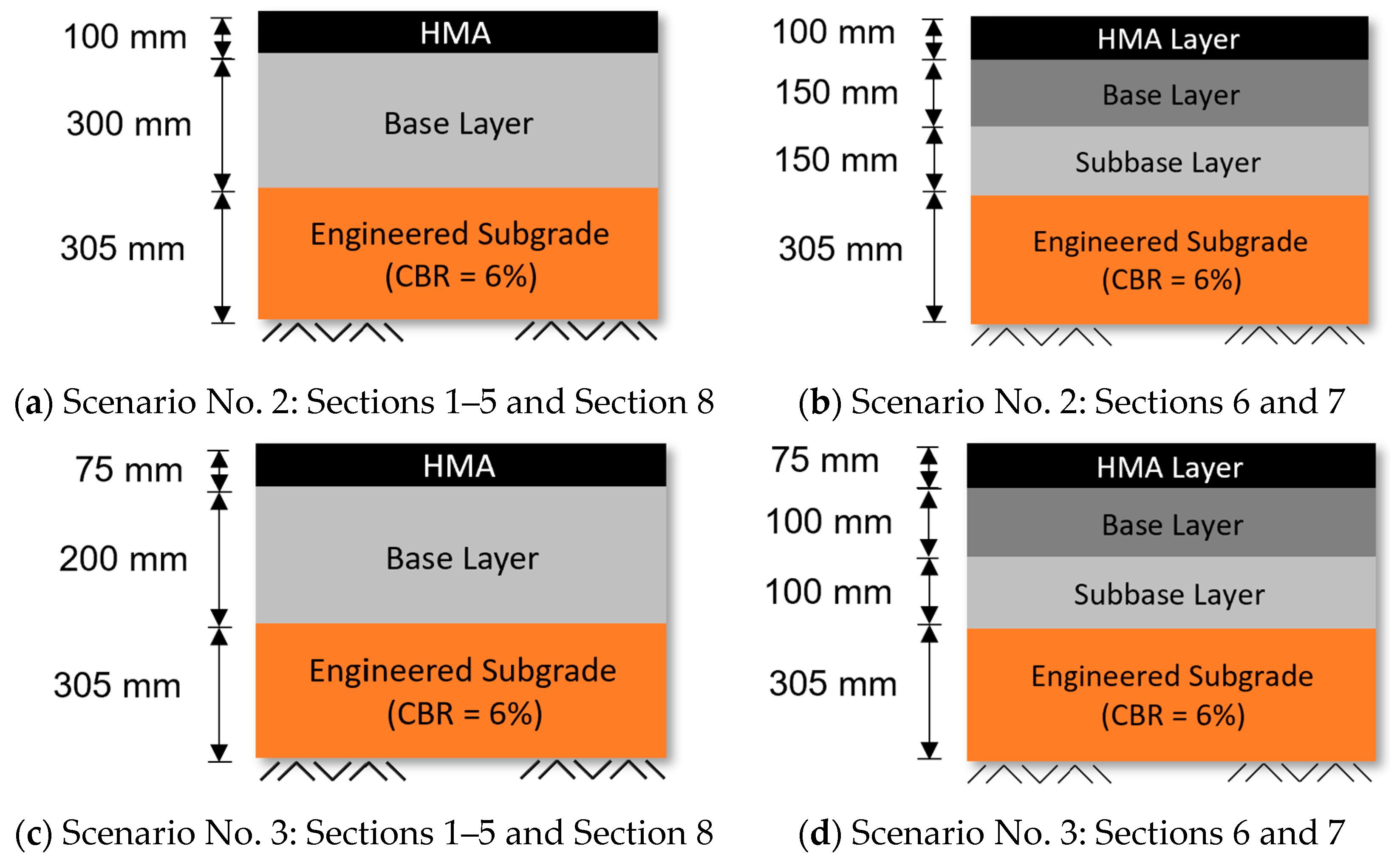
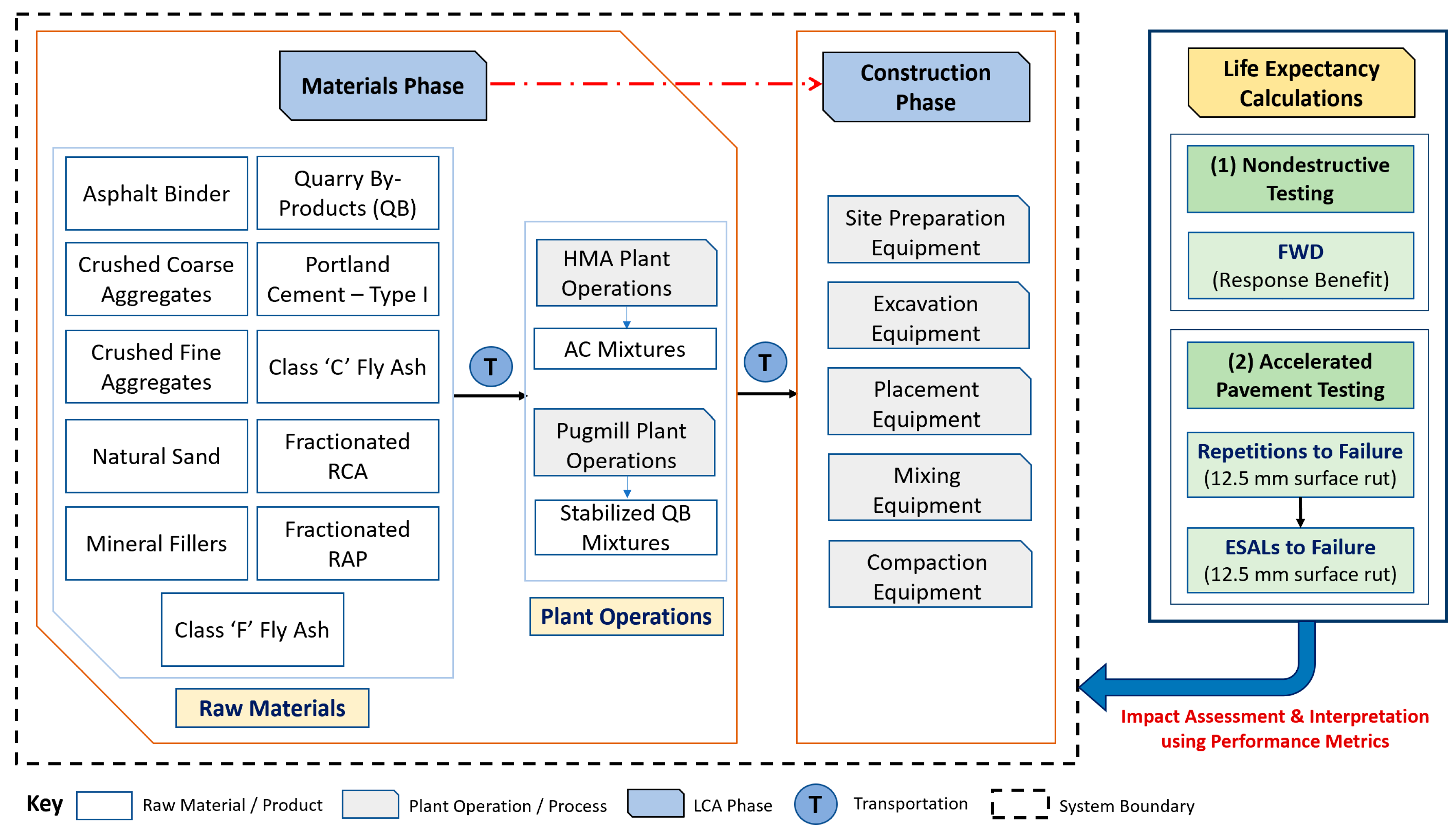
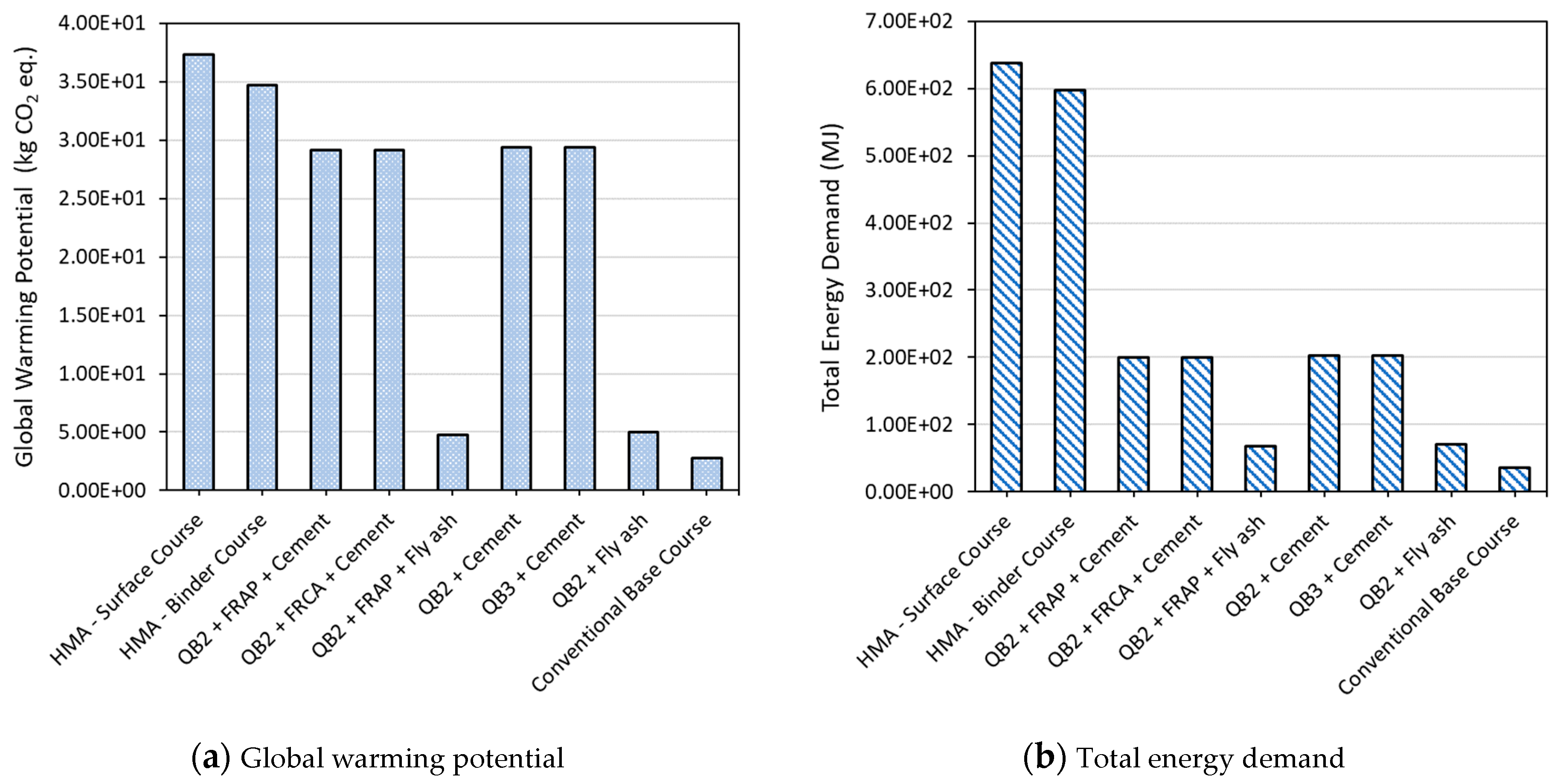

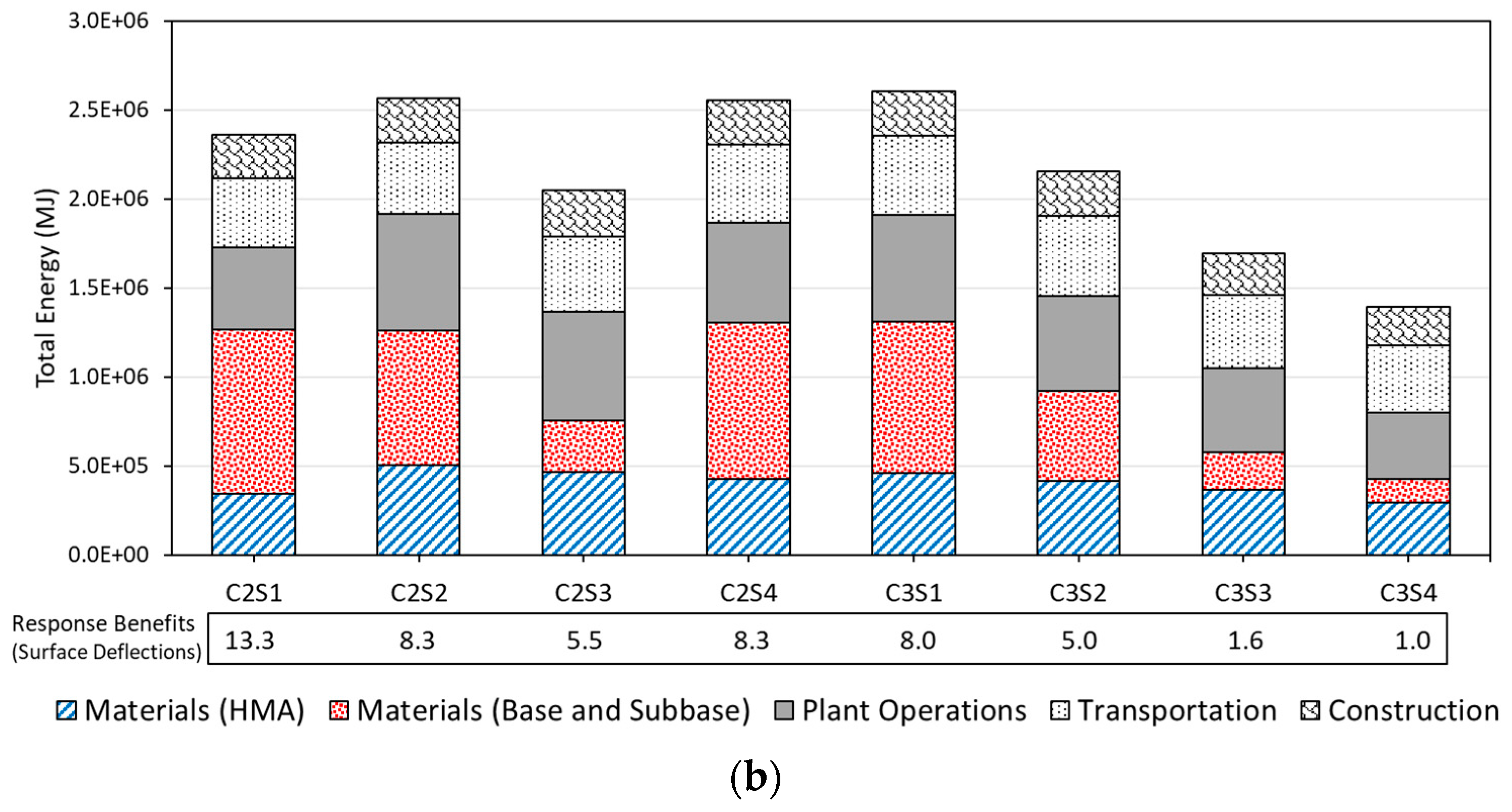
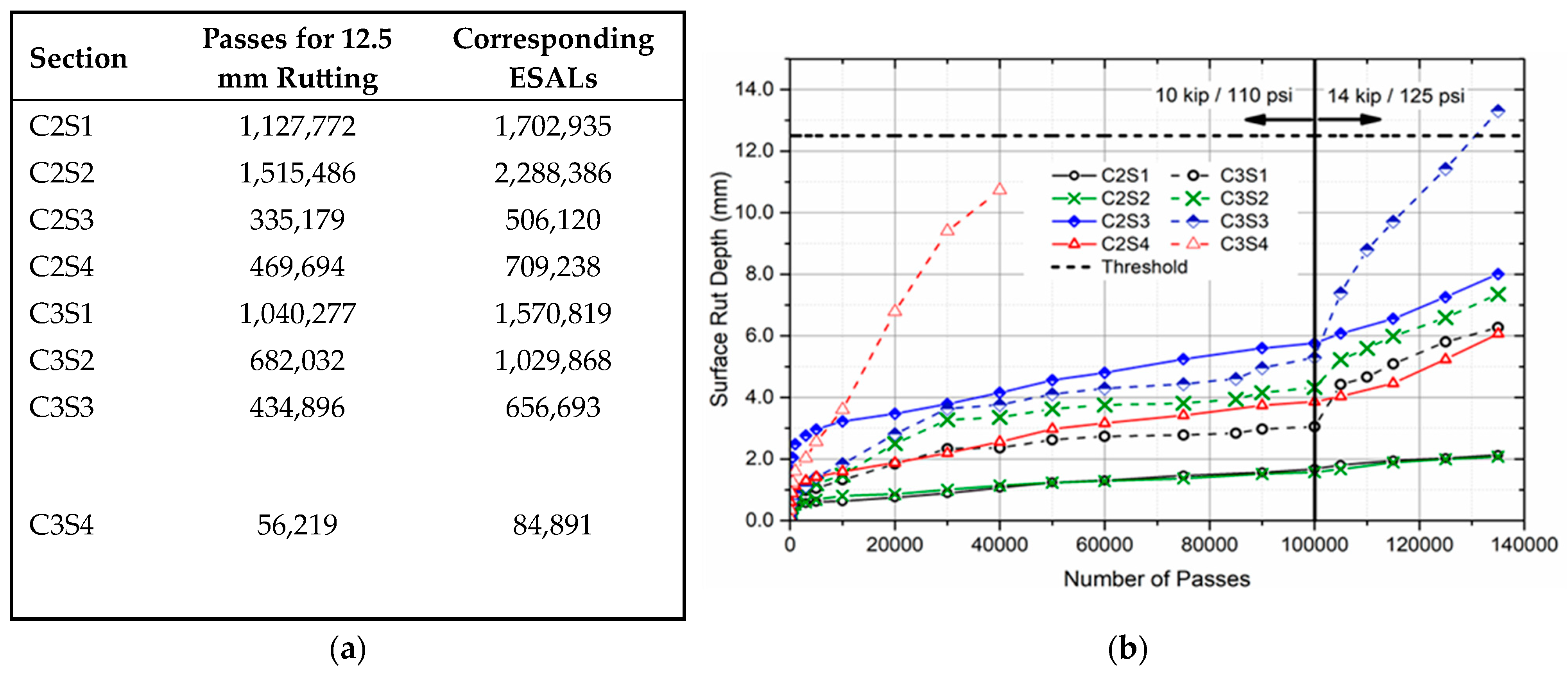
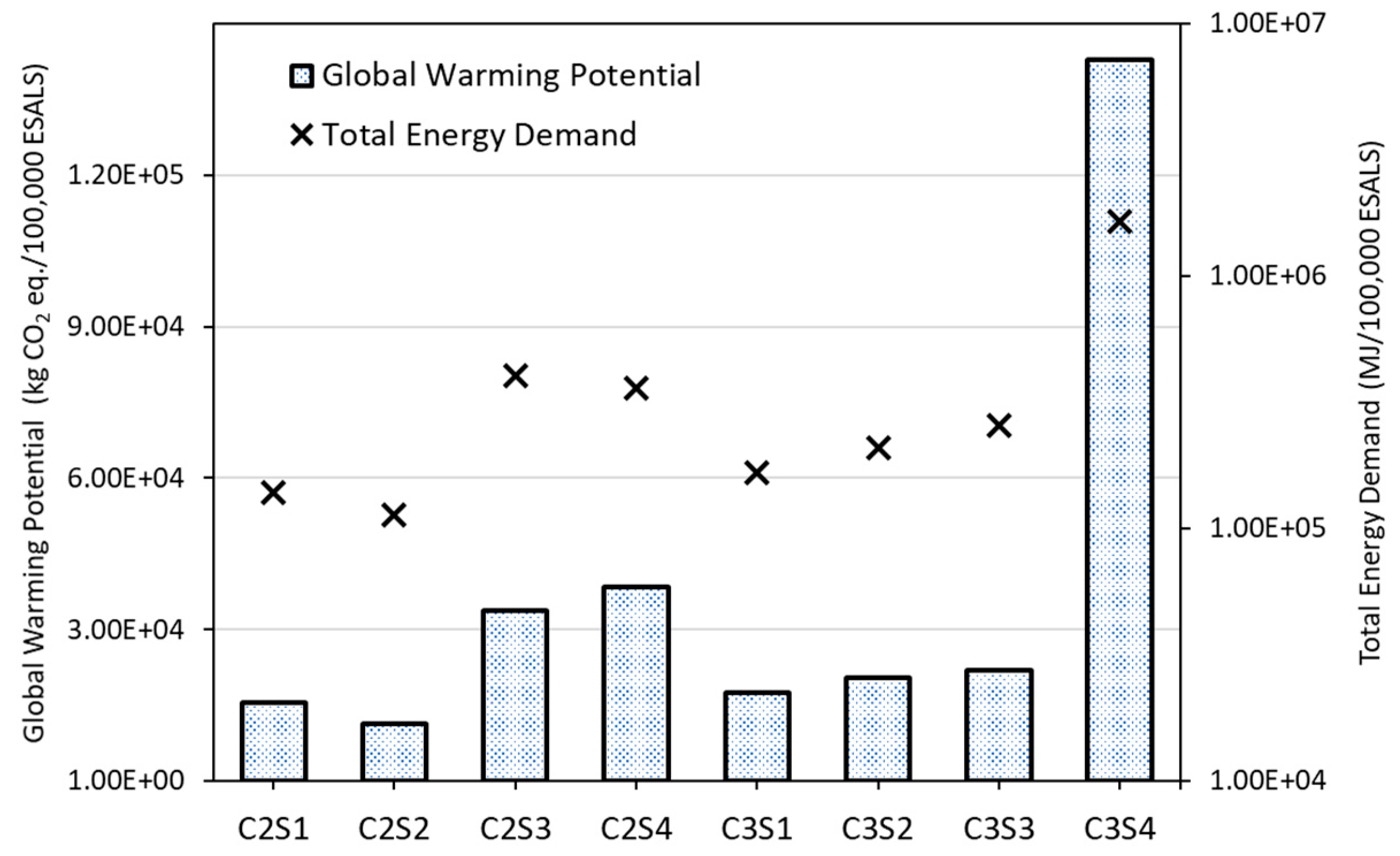
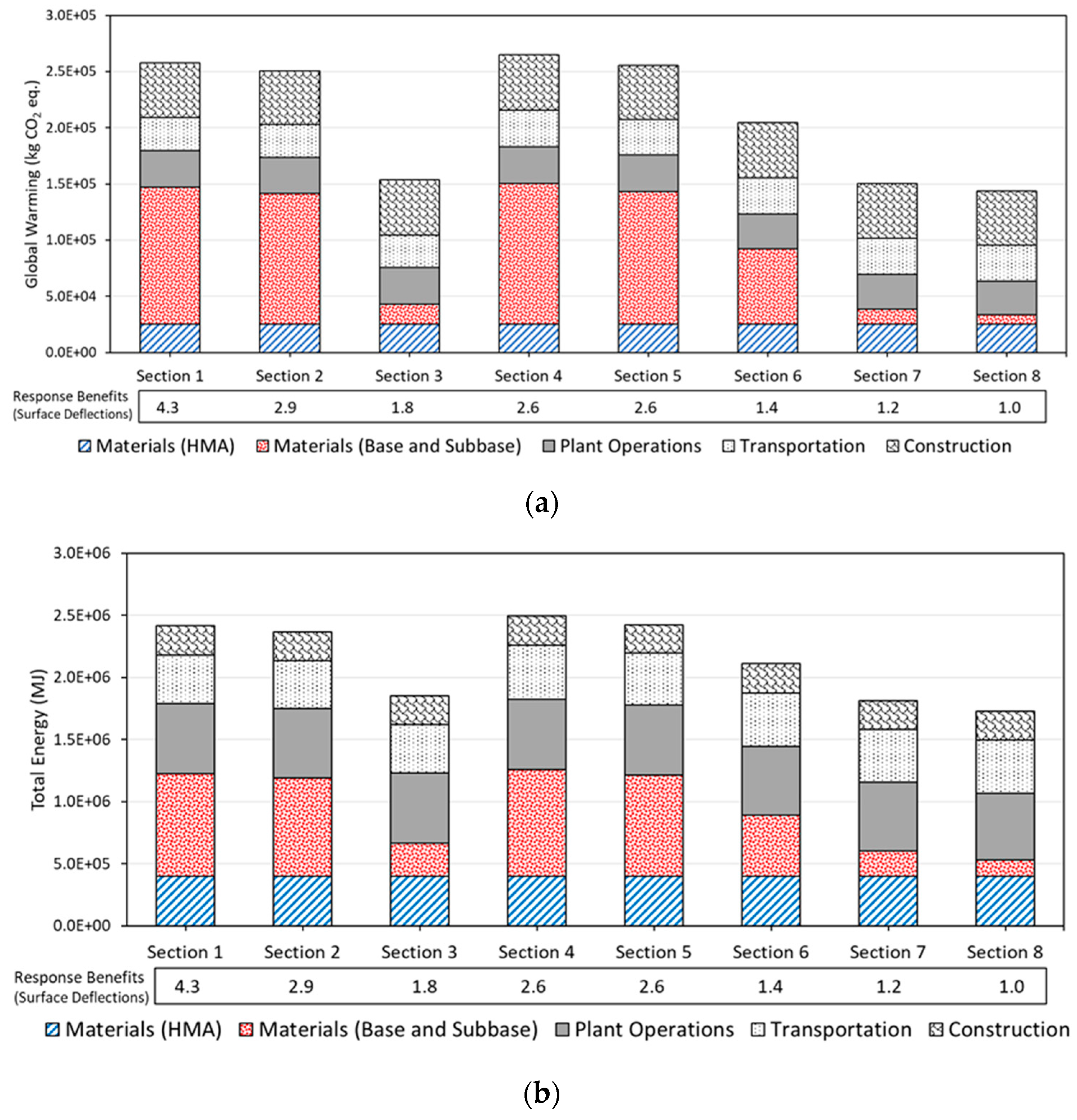
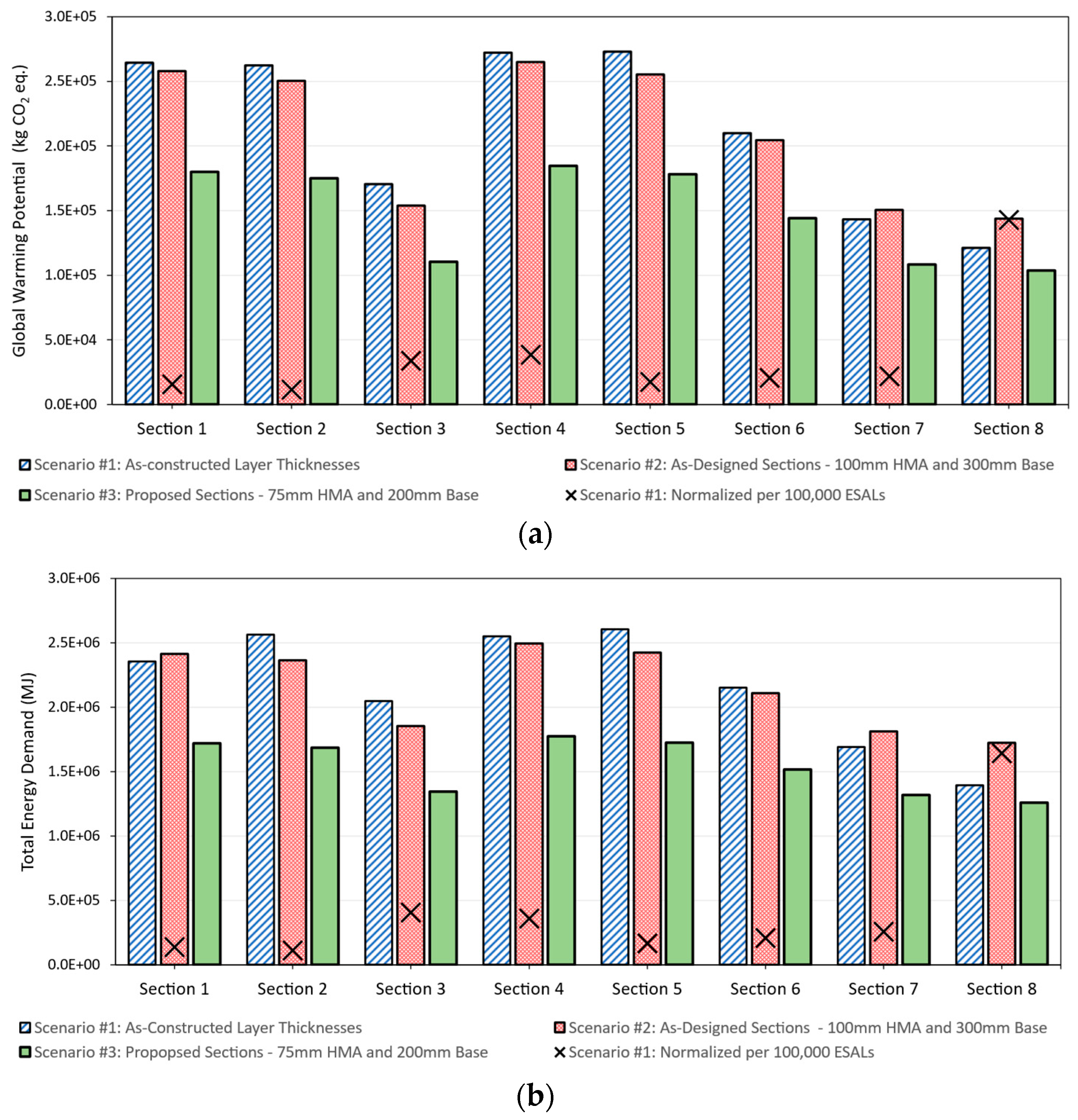
| Pavement Sections and Scenarios for LCA | Scenario #1 As-Constructed Thicknesses | Scenario #2 As-Designed Thicknesses | Scenario #3 Proposed Thicknesses | |||||||
|---|---|---|---|---|---|---|---|---|---|---|
| Section | Description of QB Application * | HMA | Base | Subbase | HMA | Base | Subbase | HMA | Base | Subbase |
| mm (in.) | mm (in.) | mm (in.) | mm (in.) | mm (in.) | mm (in.) | mm (in.) | mm (in.) | mm (in.) | ||
| Section 1 (C2S1) | Cement-stabilized base [QB2 and FRAP] | 81 (3.20) | 339 (13.36) | - | 102 (4.0) | 305 (12.0) | - | 76 (3.0) | 203 (8.0) | - |
| Section 2 (C2S2) | Cement-stabilized base [QB2 and FRCA] | 119 (4.69) | 292 (11.50) | - | 102 (4.0) | 305 (12.0) | - | 76 (3.0) | 203 (8.0) | - |
| Section 3 (C2S3) | Fly ash-stabilized [QB2 and FRAP] | 110 (4.33) | 330 (12.98) | - | 102 (4.0) | 305 (12.0) | - | 76 (3.0) | 203 (8.0) | - |
| Section 4 (C2S4) | Cement-stabilized QB2 base | 100 (3.94) | 313 (12.31) | - | 102 (4.0) | 305 (12.0) | - | 76 (3.0) | 203 (8.0) | - |
| Section 5 (C3S1) | Cement-stabilized QB3 base | 109 (4.28) | 318 (12.53) | - | 102 (4.0) | 305 (12.0) | - | 76 (3.0) | 203 (8.0) | - |
| Section 6 (C3S2) | Cement-stabilized QB2 Subbase Granular base | 98 (3.88) | 152 (6.00) | 175 (6.88) | 102 (4.0) | 152 (6.0) | 152 (6.0) | 76 (3.0) | 102 (4.0) | 102 (4.0) |
| Section 7 (C3S3) | Fly-ash stabilized QB2 Subbase Granular base | 86 (3.38) | 165 (6.50) | 149 (5.88) | 102 (4.0) | 152 (6.0) | 152 (6.0) | 76 (3.0) | 102 (4.0) | 102 (4.0) |
| Section 8 (C3S4) | Conventional aggregate base | 70 (2.75) | 308 (12.13) | - | 102 (4.0) | 305 (12.0) | - | 76 (3.0) | 203 (8.0) | - |
| Section | Description | Rut Depth at 100,000 Passes | Rut Depth at 135,000 Passes | Base/Subbase Layer(s) Thickness | Composite modulus of Base/Subbase | Subgrade Pressure (<100,000 Passes) | Subgrade Pressure (>100,000 Passes) |
|---|---|---|---|---|---|---|---|
| (mm) | (mm) | (mm) | (MPa) | (kPa) | (kPa) | ||
| C2S1 | Cement-stabilized [QB2 and FRAP] | 0.63 | 2.13 | 339 | 2755 | 11.2 | 15.7 |
| C2S2 | Cement-stabilized [QB2 and FRCA] | 0.80 | 2.08 | 292 | 2097 | - | - |
| C2S3 | Fly ash-stabilized [QB2 and FRAP] | 3.23 | 8.01 | 330 | 955 | - | |
| C2S4 | Cement-stabilized QB2 | 1.59 | 6.07 | 313 | 1793 | 14.8 | 28.2 |
| C3S1 | Cement-stabilized QB3 | 3.05 | 6.27 | 318 | 1588 | - | - |
| C3S2 | Cement-stabilized QB2 Subbase Conventional aggregate base | 4.33 | 7.35 | 327 | 557 | 12.8 | 21.2 |
| C3S3 | Fly-ash stabilized QB2 Subbase Conventional aggregate base | 5.30 | 13.31 | 314 | 227 | - | - |
| C3S4 | Conventional aggregate base | >Threshold (10.8 mm after 40,000 passes) | 308 | 180 | 63.9 | 81.4 | |
| Activities | Production Rate | Fuel Usage |
|---|---|---|
| Site Preparation Clearing-Medium | 708 m2/h (0.175 acre/h) | 160.4 L/Dunam (171.5 Gallons/Acre) |
| Subgrade Preparation Grading-Dirt-Off Road-Short Haul | 164.6 m3/h (215.32 yd3/h) | 1.302 L/m3 (0.263 Gallons/ yd3) |
| Subgrade Preparation Strip Topsoil | 91.7 m3/h (120 yd3/h) | 0.827 L/m3 (0.167 Gallons/yd3) |
| Base Stone Construction Stabilized QB Construction | 196.9 tonne/h (217 ton/h) | (1.693 L/tonne (0.406 Gallons/ton) |
| HMA Layers Construction HMA-Binder Course, 0–8 km (0–5 mi) haul | 181.5 tonne/h (200.06 ton/h) | 2.42 L/tonne (0.58 Gallons/ton) |
| HMA Layers Construction HMA-Surface Course; 0–8 km (0–5 mi) haul | 136.1 tonne/h (150 ton/h) | 3.214 L/tonne (0.77 Gallons/ton) |
| HMA Layers Construction HMA-Leveling Course, 0–8 km (0–5 mi) haul | 117.9 tonne/h (130 ton/h) | 3.72 L/tonne (0.892 Gallons/ton) |
Disclaimer/Publisher’s Note: The statements, opinions and data contained in all publications are solely those of the individual author(s) and contributor(s) and not of MDPI and/or the editor(s). MDPI and/or the editor(s) disclaim responsibility for any injury to people or property resulting from any ideas, methods, instructions or products referred to in the content. |
© 2023 by the authors. Licensee MDPI, Basel, Switzerland. This article is an open access article distributed under the terms and conditions of the Creative Commons Attribution (CC BY) license (https://creativecommons.org/licenses/by/4.0/).
Share and Cite
Qamhia, I.I.A.; Tutumluer, E.; Ozer, H. Life Cycle Assessment of Aggregate Quarry By-Product Fines in Pavement Applications. Sustainability 2023, 15, 10705. https://doi.org/10.3390/su151310705
Qamhia IIA, Tutumluer E, Ozer H. Life Cycle Assessment of Aggregate Quarry By-Product Fines in Pavement Applications. Sustainability. 2023; 15(13):10705. https://doi.org/10.3390/su151310705
Chicago/Turabian StyleQamhia, Issam I. A., Erol Tutumluer, and Hasan Ozer. 2023. "Life Cycle Assessment of Aggregate Quarry By-Product Fines in Pavement Applications" Sustainability 15, no. 13: 10705. https://doi.org/10.3390/su151310705





